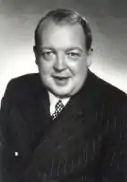Alexander Gauge
Alexander Gauge (29 July 1914 – 28 August 1960) was a British actor best known for playing Friar Tuck in The Adventures of Robin Hood from 1955 to 1959.
Alexander Ralph Gauge | |
|---|---|
 Alexander Gauge | |
| Born | 29 July 1914 Wenzhou, China |
| Died | 28 August 1960 (aged 46) |
| Nationality | British |
| Occupation | Actor |
Born in a Methodist Mission station in Wenzhou in China,[1] Gauge was a well-known English character actor. Gauge attended school in California before moving to England. He served in the British Army in India during World War II, where he became acquainted with John Masters. He first appeared on the New York stage in 1945. He acted in many of Shakespeare's plays, and usually played villains in British films, but many considered his forte to be comedy.[1] He was a great hit in the London stage production of The Seven Year Itch.[2]
Gauge appeared in the films The Interrupted Journey in 1949, and, all in 1952, Murder in the Cathedral, Mother Riley Meets the Vampire, with Old Mother Riley and Béla Lugosi, and The Pickwick Papers. He also appeared in the films Martin Luther (1953), Beau Brummell (1954), The Green Man (1956) and The Iron Petticoat (1956) starring Bob Hope. In 1955 he joined the cast of both The Scarlet Pimpernel (as George, the Prince Regent) and The Adventures of Robin Hood, as Friar Tuck, a role he played until 1960. In 1959 Gauge starred as Brigadier Wellington-Bull in the series The Adventures of Brigadier Wellington-Bull alongside Valerie Singleton.
In 1960, just weeks before his death, he played the Duke of Norfolk in the original West End production of A Man for All Seasons at the Globe Theatre. His last performance was a posthumous appearance in the 1961 film Nothing Barred starring Brian Rix.
Gauge married Phyllis Anne Young in Penzance in 1957. He died aged 46 from an overdose in Woking in Surrey in 1960. However, his death certificate, issued by the General Register Office for England and Wales, lists the cause of death as a malignant brain tumour.[1]
Partial filmography
- The Interrupted Journey (1949) - Jerves Wilding
- Flesh and Blood (1951) - Coutts
- Murder in the Cathedral (1951) - King Henry II
- Mother Riley Meets the Vampire (1952) - Police Constable (uncredited)
- Penny Princess (1952) - MacNabb the Lawyer (uncredited)
- The Pickwick Papers (1952) - Tracy Tupman
- The Great Game (1953 film) - Ben Woodhall
- Martin Luther (1953) - Tetzel
- The Square Ring (1953) - 2nd Wiseacre
- House of Blackmail (1953) - Markham
- Counterspy (1953) - Smith
- Will Any Gentleman...? (1953) - Mr. Billing
- Fast and Loose (1954) - Hankin
- Double Exposure (1954) - Denis Clayton
- Dance, Little Lady (1954) - Joseph Miller
- The Golden Link (1954) - Arnold Debenham
- Beau Brummell (1954) - Newspaper Man (uncredited)
- Tiger by the Tail (1954) - Fitzgerald
- Mystery on Bird Island (1954) - Bronson
- Scotland Yard (1954, Episode: "The Blazing Caravan")
- Before I Wake (1955) - Police sergeant
- The Hornet's Nest (1955) - Mr. Arnold
- Reluctant Bride (1955) - Humbold
- No Smoking (1955) - Wellington-Simpson
- Handcuffs, London (1955) - Nicholas Bardwill
- Port of Escape (1956) - Inspector Levins
- The Iron Petticoat (1956) - Senator Howley
- Breakaway (1956) - MacAllister
- The Green Man (1956) - Chairman
- The Passionate Stranger (1957) - Master of Ceremonies at Dance
- Les canailles (1960) - Chalmers
- Nothing Barred (1961) - Traffic Policemen (final film role)
References
- Biography of Gauge Archived 2010-06-23 at the Wayback Machine
- 'The Adventures of Robin Hood' website